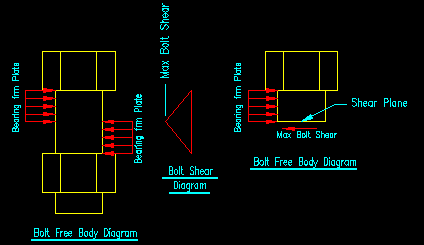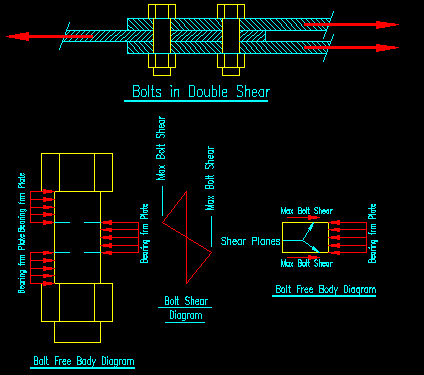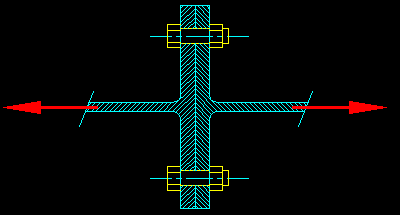|
|
|
Purchase Hard Copy |
Section 4.2
Mechanics of Load Transfer
Figure 4.2.1 |
|
|
|
Figure 4.2.2 |
|
|
Figure 4.2.3 |
 |
Mechanical Fasteners (i.e., bolts, rivets, and pins) are most frequently used in structural steel connections where the load direction is perpendicular to the bolt axis as shown in Figure 4.2.1. In this situation the principle force in the bolt is shear.
Less frequently, the bolts are placed such that their axis is parallel to the direction of force as shown in Figure 4.2.2. Here the bolts the principle force in the bolts is tensile.
Let's look at the force transfer mechanisms in more detail.
A Bolt in Shear
As mentioned in the prior section, bolts may be installed as snug tight or fully tensioned, the difference being that the snug tight installation does not provide a significant clamping force between the connected members. Let's begin this discussion by considering a fully tensioned bolt.
If you were to place the connection shown in Figure 4.2.1 in a tension test, the force vs. deformation curve would look something like what is shown in Figure 4.2.3.
As the load is progressively applied to the connection, the major force transfer between the connected plates would be by friction. The friction capacity is the result of the normal force (N) between the plates created by the bolt tension and the roughness of the contact surfaces (quantified by the friction coefficient, m. From your statics course, you will recall that the friction capacity equals mN. Once the applied force exceeds the friction capacity (i.e., the nominal slip capacity), the connected members slip relative to each other until they bear on the bolts. (Recall that the bolt diameters are smaller than the hole diameters, which allows this slip to occur.) After slip occurs the force is then transferred by bearing between the edge of the hole and the bolt to the bolt. The bolt carries the force by shear to the adjacent connected plate where it is transferred to the plate by bearing between the bolt and the edge of the hole. Failure of the connection then results from exceeding the shear capacity of the bolt or one of the bearing limit states discussed with tension members.
As can be seen in Figure 4.2.3, every connection will have two shear capacities:
- the capacity to carry load without slip and
- the capacity to carry load without shear failure of the bolts.
The first is called the NOMINAL SLIP CRITICAL capacity. The second is called the NOMINAL BEARING capacity. The SCM provides equations for computing these quantities for various bolts.
In a snug tight connection slip occurs at much smaller loads so the nominal slip capacity is negligible. The only capacity available for a snug tight connection is the nominal bearing capacity.
To understand the force transfer in bearing a bit better, let's take a closer look at a free body diagram of the bolt (Figure 4.2.4).
Figure 4.2.4
Single Shear Bolt

The plates each bear on a separate side of the bolt. We will idealize the force distribution as a uniformly distributed load along the bolt in each case. The resulting shear diagram is shown. The maximum shear in the bolt occurs at the contact surface of the connected plates. The strength capacity of the bolt, then, is the shear strength of the bolt where the shear is at its maximum. If the maximum shear force exceeds the capacity of the bolt, then the bolt will experience a shear failure.
The shear capacity of the bolt can be idealized as some material-based shear strength times area of the failure surface (i.e., the cross-sectional area of the bolt).
The location of maximum shear in the bolt is commonly referred to as a SHEAR PLANE. The bolt depicted in Figure 4.2.4 is referred to as a "single shear bolt" since it has only one critical shear plane. It is possible to have more than one critical shear plane. Figure 4.2.5 shows a bolt that has two critical shear planes. These bolts are said to be in "double shear" and can transfer twice as much force as a bolt in single shear. It is possible to have even more planes of shear.
Figure 4.2.5
Double Shear Bolt

A Bolt in Tension
The mechanics of a bolt in tension are less complicated than for a bolt in shear. In this case there is no slip to consider. Also there are no shear planes. The capacity of a bolt is the same regardless of the number of plates being connected together. The tensile force is parallel to the bolt axis and is considered to be concentric with the bolt's cross-sectional area, resulting in uniform stress across the section as depicted in Figure 4.2.6.
An interesting phenomenon to consider when contemplating the physics of this arrangement is that bolt pretension does not enter into the problem. It turns out that, as tensile load is applied to a connection it will reduce the contact pressure between connected members first. The bolts see no tensile force beyond the pretension force until the contact stress between the connected members is overcome.
The approximation used in the SCM is that contact stress and the bolt pretension are ignored when computing applied tensile stress, ft, and the force is assumed to be actually applied to the bolt.
Figure 4.2.6
Bolt In Tension

<<< Previous Section <<< >>> Next Section >>>

